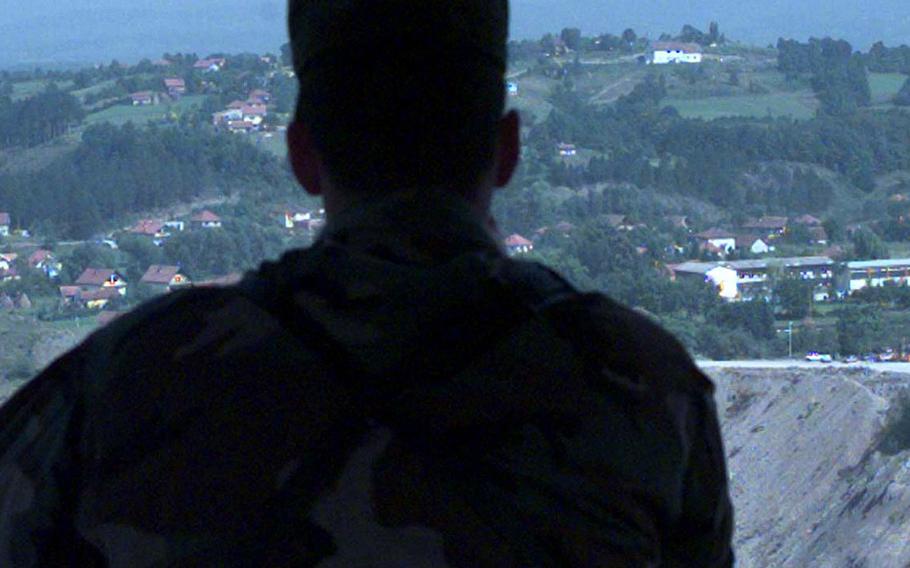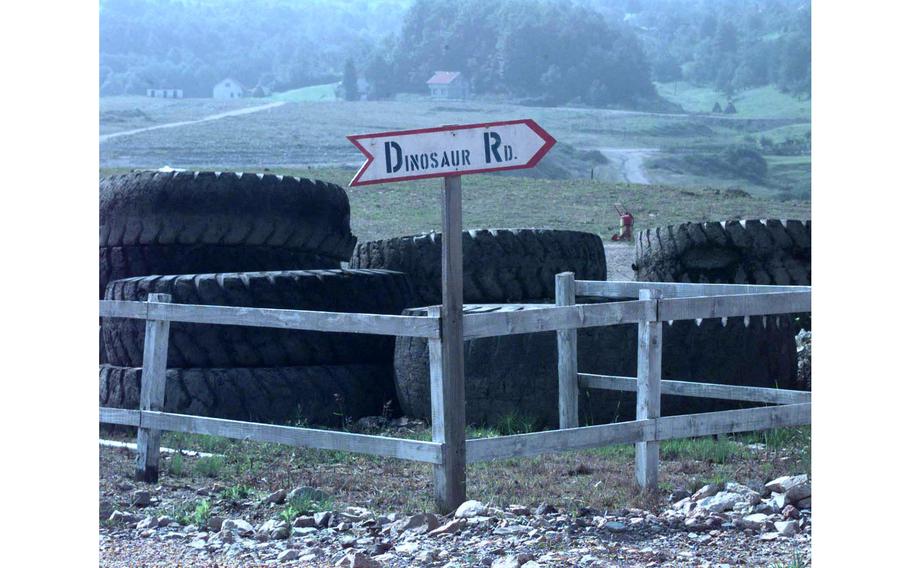
The Mayor of Camp Bedrock, Capt. David Miller looks out over the villages in the valley and the quarry which Camp Bedrock was built upon. (Diane S. Lundholm/Stars and Stripes)
This article first appeared in the Stars and Stripes Europe edition, Sept. 15, 1997. It is republished unedited in its original form.
Capt. David Millner has the dubious distinction of being the mayor of a base called Bedrock — a U.S. camp on a towering mound of rubble in the Tuzla Valley where SFOR veterans look forward to ending their tours and new soldiers size up the months to come.
The name, like the camp’s peacekeeping mission, is a legacy passed down to 1st Armored Division troops, said Millner, a St. Louis native. Originally, the camp was occupied by engineers, he said.
“As I understand it, they were up on this hill,” he said. “They saw an enormous crane, and a guy said it looked like the one used by Fred Flinstone” in the old popular cartoon series.
The crane, a faded mixture of lime green and white painted metal, several stories high, still rumbles and clanks in a coal mining pit on the camp’s north side, scooping up chunks of the Bosnian countryside, said Millner.
Around 1,000 soldiers are based at the camp, which stretches more than half a mile across the mounded debris from two massive strip-mining pits, said camp spokesman Capt. Rob Thelen from Atlanta.
Bedrock is the headquarters for Task Force 2nd Battalion, 2nd Infantry (mechanized) and its reserve forces, Charlie Company 1-77 Armor from Schweinfurt, Germany; for the 642nd Engineer Company from the 10th Mountain Division at Fort Drum, N.Y.; and the 108th Military Police Company from Forth Bragg, N.C.
During the war, there was a struggle for control of the area, located 30 minutes southwest of Tuzla, said Thelen. Today, the hills, and brief patches of farmland are quiet.
Armored vehicles are the only dinosaur-sized creatures moving around the hill.
Pfc. Ruel Thompson, working in a trademark Army brown T-shirt, cinched metal bands around a worn tank tread on a pallet. Nearby soldiers from his unit, Charlie Company, 1st Battalion, 77th Armor, were threading a new track around the road wheels of a M1 Abrams tank. Asphalt roads eat up the rubber pads set in the track’s metal segments, Thompson said.
A loader on an Abram’s crew, Thompson said he was looking forward to redeploying to Germany and then going on leave to his hometown of Boston where his mother had been redecorating. The smiling soldier said he wants to see what all the fuss is about back home.
Home for Thompson, like most 1st Infantry Division soldiers who have been at Bedrock since March, may be coming closer now that Bosnia’s municipal elections — conducted this past weekend — are over.
Bedrock has been quiet, almost to the point of boredom, according to Spec. Mark Sorrentino, assigned to Headquarters Company, 2nd Battalion, 2nd Infantry (mechanized). The Pensacola, Fla., native said he has lived at the camp since deploying with the 1st Infantry Division from Vilseck, Germany. Back in Germany, he has a wife and son.
“Everybody lives eight people to a tent,” Sorrentino said of life at Bedrock. “Most people call it the ‘rock,’ there’s no real vegetation.”
At night, most soldiers watch movies, sit and talk, he said. “A lot of us are getting ready to go back.”
The camp became crowded with the buildup of U.S. forces for the elections, said Pvt. 2 P.J. Vicknair, a Humvee driver for the 2nd Armored Cavalry Regiment. Camp newcomers, members of the 2nd Cavalry Regiment, will stay at base camps in Bosnia after the 1st Infantry Division redeploys to Germany. Since rolling into Bosnia around the middle of August, Vicknair said he has visited Camp Demi and driven by Dobol.
A single soldier from Wichita Falls, Texas, Vickair said there are no clubs to cruise. Otherwise, life at Bedrock is good.

As you would expect to see in a camp named “Bedrock” — inspired by the classic “Flintstones” cartoon — a road sign marks Dinosaur Road. (Diane S. Lundholm/Stars and Stripes)
The heart of the camp is based around the dining facility, a band of trailers bordered by a wooden patio. Tents house a camp store, cappuccino bar, shoe shop and tailor.
There is also a gym and recreation center. A lighted volleyball court is a popular draw with organized tournaments competing for camp honors.
“Bedrock is the best base camp in theater. The cappuccino shop is excellent,” said Sgt. Frank Judge, a Charlie Company, 1st Battalion, 77th Armor soldier from Schweinfurt.
Everything is centrally located on the mountain of gravel and dirt, he said.
Judge’s unit, a reserve force for 1-77 elements based in the zone of separation around Brcko, pulls security patrols and does weapons storage site inspections. In July, his team spent two weeks at McGovern. It was back at the base camp last week as tensions flared in Brcko.
“It’s always good to be back at Bedrock,” Judge said.
Given its vantage point, soldiers can see anyone rolling up the hill toward Bedrock, Millner said. A wide road curves up the hill into the camp.
“We have a great location, a view nobody can touch,” Millner said.
Following a trend where headquarters company commanders serve as camp mayors, Millner said he has served as the camp’s chief military administrator since arriving with the 1st Infantry Division in March.
By trade he is the commander for Headquarters and Headquarters Company, 2nd Battalion, 2nd Infantry (mechanized), based in Vilseck, Germany.
His job as mayor involves mediating neighbors’ complaints ‘anything from folks playing basketball too early or too late at night to playing their music too loud.”

Mayor of Camp Bedrock, CAPT David Millner of the HHC, 2-2 Infantry. His job as mayor is to mediate complaints — to make sure people are being “good neighbors”. (Diane S. Lundholm/Stars and Stripes)
His other duties include posting policies that are standard at U.S. camps such as what uniforms troops are allowed to wear while off duty to making sure people wash their hands before going into the dining facility, which recently took quarterly honors as the best in Bosnia.
Dinosaur Road at Bedrock leads to a watchtower manned by Spec. Cain Woodland, a member of Ghost Troop, 2nd Armored Cavalry Regiment.
Worn, monstrous tires from wheeled mining equipment are stacked along the mound’s edge as part of a defensive perimeter.
Down the hill lies “Pebbles,” a pit where engineers keep their earth-moving equipment.
When Woodland, who hails from “a small town near Philadelphia, Pa.,” heard the camp’s name, he immediately thought of the Flintstones. And he has found being there rather pleasant.
“It’s pretty scenic up on the hill,” he said as he pulled guard duty. He has a nice view past the ravaged mining pits toward the rolling, tree covered countryside.
It will be short tour for Woodland, who separates from the service in December. Still he said, all considered Bedrock wouldn’t be a bad place to spend a deployment.
Want to read more of Stars and Stripes’ 1990s coverage of former Yugoslavia? Subscribe to Stars and Stripes’ historic newspaper archive! We have digitized our 1948-1999 European and Pacific editions, as well as several of our WWII editions and made them available online through http://starsandstripes.newspaperarchive.com/